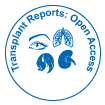Nuestro grupo organiza más de 3000 Series de conferencias Eventos cada año en EE. UU., Europa y América. Asia con el apoyo de 1.000 sociedades científicas más y publica más de 700 Acceso abierto Revistas que contienen más de 50.000 personalidades eminentes, científicos de renombre como miembros del consejo editorial.
Revistas de acceso abierto que ganan más lectores y citas
700 revistas y 15 000 000 de lectores Cada revista obtiene más de 25 000 lectores
Indexado en
- Búsqueda de referencia
- Universidad Hamdard
- EBSCO AZ
Enlaces útiles
Revistas de acceso abierto
Comparte esta página
Abstracto
Advancements and Challenges in Kidney Transplantation: A Comprehensive Review
Noah S
Kidney transplantation stands as the preferred treatment for end-stage renal disease (ESRD), offering patients a chance at improved quality of life and prolonged survival. This comprehensive review explores the recent advancements and challenges in kidney transplantation, shedding light on critical aspects of donor selection, surgical techniques, immunosuppressive therapies, and post-transplant care. The first section examines the evolution of donor criteria, encompassing innovations such as expanded criteria donors (ECD) and living kidney donation programs. A critical evaluation of the ethical and medical considerations in donor selection is presented, addressing the ongoing debate surrounding organ shortages and the quest for alternative sources. The second part delves into surgical techniques, discussing the emergence of minimally invasive approaches and the role of robotic-assisted surgery in improving patient outcomes. Innovations in organ preservation methods, including hypothermic machine perfusion, are explored, emphasizing their potential to extend the viability of donor organs and optimize transplant success. Immunosuppressive therapies take center stage in the third section, with a focus on personalized medicine approaches and the development of novel agents that aim to balance the delicate equilibrium between preventing rejection and minimizing drug-related complications. The review also highlights the importance of monitoring and managing immunosuppressive drug levels to ensure optimal graft function and patient well-being. The final section addresses the post-transplant period, emphasizing the significance of long-term patient management, including the detection and treatment of complications such as rejection, infections, and cardiovascular issues. The integration of telemedicine and digital health solutions into posttransplant care is explored, offering potential avenues for enhancing patient adherence and monitoring. In conclusion, this review provides a comprehensive overview of the current landscape of kidney transplantation, emphasizing the strides made in donor selection, surgical techniques, immunosuppressive therapies, and post-transplant care. However, challenges such as organ shortages and long-term complications persist, necessitating ongoing research and innovation to further improve transplant outcomes and ensure the continued success of kidney transplantation as a life-saving intervention for patients with ESRD.
Revistas por tema
- Agricultura y acuicultura
- Alimentación y Nutrición
- Bioinformática y biología de sistemas
- Bioquímica
- Ciencia de los Materiales
- Ciencia general
- Ciencias Ambientales
- Ciencias Clínicas
- Ciencias farmacéuticas
- Ciencias Médicas
- Ciencias Sociales y Políticas
- Ciencias Veterinarias
- Enfermería y atención sanitaria
- Física
- Genética y biología molecular
- Geología y Ciencias de la Tierra
- Ingeniería
- Inmunología y Microbiología
- Química
Revistas clínicas y médicas
- Anestesiología
- Biología Molecular
- Cardiología
- Cirugía
- Cuidado de la salud
- Dermatología
- Diabetes y Endocrinología
- Enfermedades infecciosas
- Enfermería
- Gastroenterología
- Genética
- Inmunología
- Investigación clínica
- Medicamento
- Microbiología
- Neurología
- Odontología
- Oftalmología
- Oncología
- Pediatría
- Toxicología

 English
English  Chinese
Chinese  Russian
Russian  German
German  French
French  Japanese
Japanese  Portuguese
Portuguese  Hindi
Hindi